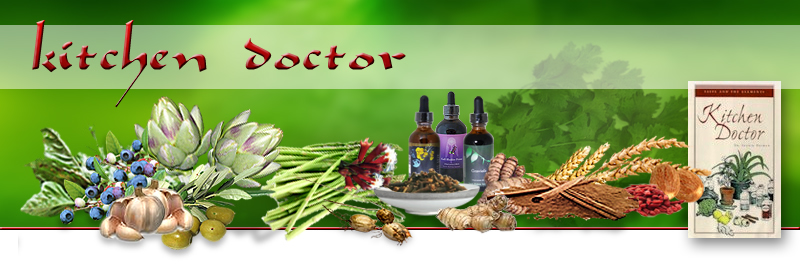Just had your first taste of Tom Kha Gai and your senses are still
reeling from the exotic citrus flavor of something that clearly
was not a fruit? Did you bite into something so exciting
and pleasant that you thought about forgetting the main course
and simply ordering more soup? The “kha” in
that soup is a fantastic member of the ginger family called
galanga or galangal. It is native to Southern China and
Thailand but was introduced to Europe in the 9th century,
almost 500 years before Marco Polo.

Galangal changed my world view,
and to it I owe more than a thousand culinary delights as well
as excellent digestion. Also, thanks to galangal, my mind
became unfettered by the history I learned in school; and I was
moved to rebuild my intellectual world as well as my herbal pharmacy.
History
Imagine zealous, sword brandishing Christian knights
left for dead on battlefields of the Holy Land depending on Jewish
and Islamic doctors to heal them. Many of these knights spent
years in the foment of spiritual and academic conflict, only to
return transformed by the world from whence the Sun rose.
The Middle East is appropriately named “middle” because
it has been a crossroads for eons, a place where prophets and physicians
meandered among camels and caravans hearing the tales of those
whose journeys originated in yet unknown parts of the world.
Why galangal? Well, my love relationship
with this delicious and fascinating herb was part three of my romance
with the ginger family, an affair that began in Hawaii with turmeric
and moved to ginger and finally its close cousin, galangal, the
culinary crown of these beautiful tropical plants.
 |
St. Hildegard of Bingen
(1098-1179) was one of the foremost herbal authorities of
her day. I had researched her formulas for my book on
botanical cancer treatments and discovered, much to my amazement,
that galangal was so highly revered by her that she actually
wrote that it had been given by God to provide protection
against illness. “The spice of life,” as
she called galangal, appears in many Hildegard formulas. |
For instance, Hildegard had a formula for deafness
due to catarrh or infection in which galangal, called “catarrh
root,” was the cornerstone. She said to take galangal
and one-third as much aloe powder as galangal plus twice as much
oregano as aloe and some peach leaves. These were mixed into
a powder and taken daily as digestive aids, both on an empty stomach
as well as a few pinches with the last bite of each meal.
For Hildegard, this remedy was not just a little
formula for deafness, but a major focus
of intent because Hildegard was, in addition, to her herbal erudition
an accomplished musician, not just a composer, but a visionary
who understood the profound relationship of hearing to health.
In Hildegard’s medicine, the powerful adjudicators
of fate, the determinants of happiness or misfortune as well as
health or sickness, depend on hearing. She felt that metabolism
is affected by the liver which, in turn, has a direct relationship
to the ears and hearing. Harsh sounds can disturb bodily
fluids, and fluids that contact blood vessels impact hearing when
they reach the ears. Hildegard believed that health is earned
or forfeited partly as a consequence of what we hear. To
offset the shock to the liver of sounds that undermine health,
Hildegard composed scores of chants and a musical drama called “Ordo
Virtutem,” and, as we see, she also prescribed this interesting
galangal formula as a digestive aid.
Galangal was also the principle herb of Hildegard’s
three-week cure for heart problems. She had a pill, a juice,
and a powder for heart pain. The
pills were to be taken three times a day, after meals during the
first week and between meals for the next two weeks. The
pills consisted of equal parts of galangal and pellitory, a perennial
herb that is native to the Mediterranean as far east as the Middle
East, and a quarter as much white pepper. These were to mixed
with a meal made from fava beans. It was moistened with fenugreek
juice or wine. These pills reduce heart pain.
The second part of her remedy relied on licorice
and fennel seeds, one part licorice to five parts fennel and five
parts sugar and a little honey. These were mixed with water. The
powder used white pepper, one-third as much cumin and fenugreek
as pepper. These were powdered and put on bread. These
remedies were used to reduce pain and the fear that, in her estimation,
brings on heart attacks.
Hildegard regarded galangal mainly as a potent
aid to digestion and quick reliever of pain, such as the pain associated
with angina pectoris, heart attacks, and gall bladder symptoms. The
heart symptoms are secondary to the gastric distress, which, if
relieved, eases cardiac pressure. Physicians in Germany who
have taken up Hildegard Medicine as their calling have reported
that galangal is as effective as nitroglycerin, but it has absolutely
no harmful side effects. These same researchers point out
that Hildegard, with her mystical vision, was the first and thus
far the only herbalist to note the effect of galangal as a heart
pain reliever:
Whoever has heart pain and is weak in the
heart should instantly eat enough galangal, and he or she will
be well again.
Physica
According to contemporary herbal sources, galangal
is a warming, digestive tonic with a stimulating and carminative
effect on digestion. Simply stated, it promotes the secretion
of gastric juices, aids peristalsis, and relieves gas in the gastrointestinal
tract. Anyone who has tasted galangal knows this to be true;
they may even recognize that it dispels those disturbing gases
that make one want to heave after a heavy meal. What is less
well known is that these very same gases, by-products of fermentation
when digestive action is not strong enough to metabolize an entire
meal, circulate throughout the system causing spasms,
everything from hiccups to sharp cardiac
pains. What carminative spices do is neutralize the gases
so that they cease to exist! By doing this, the many symptoms
of the invisible but gusty winds subside.
On a psychological level, the predominant symptom
of wind or air is anxiety, what I refer to as “groundless
fears,” worries based on “nothing.” When someone’s
system is overexcited by excess air, the person finds it harder
to focus. As concentration is impaired, people tend to make
careless mistakes. They “lose their centers” and
begin running on nervous energy, which, of course, causes a lot
of wear and tear on the body as well as psyche. For instance,
in rushing into a car to get somewhere in a hurry, one may get
halfway down the block only to ask whether the front door was locked
on the way out. Odds favor that one locked the door because
this is something one does on auto pilot; but with excess air,
one ceases to be sure.
The question is whether to go home and check the
front door and risk being even later to one’s next appointment
or to go where one is going and worry all day about the front door. What
is so intriguing about carminative herbs is that these psychosomatic
symptoms that seem to have no basis in physiology subside when
wind relieving foods and spices are used. In all my carminative
formulas, galangal plays a key role. I have it in my teas
and intestinal formulas because, like Hildegard, I have found it
to be without equal. I even put galangal in some of the medicinal
jams that I make.
Like most spices, galangal promotes digestion,
assimilation, and elimination. According to Ayurveda, my
own particular area of intense study, food that is not metabolized
forms a substance called “ama” in Sanskrit, probably
a term very close in meaning to Hildegard’s catarrh. Ama is
a sticky substance, a metabolic a residual that forms when the
anabolic and catabolic processes are not in perfect balance.
When people have low metabolisms, their output
of saliva and gastric juices as well as insulin and enzymes is
insufficient to complete digestion of an ordinary meal. In
such instances, some food is broken down by fermentation instead
of digestion. This fermentation causes a host of abdominal
rumblings as well as distention and other miseries. Heartburn
comes after the bloating and discomfort.
Galangal is the herb of choice in relieving both
the short- and long-term consequences both of sluggish metabolism
and overeating, a holiday risk. Personally, I prefer, as
the Thais do, to cook my food with spices so that the food itself
is easier to digest, but digestive and carminative herbs can also
be taken as supplements or post-digestive tonics, sort of like
an after dinner aperitif. A chocolate covered mint is hardly
comparable to galangal!
Today, galangal is available in the frozen food
section in Asian food stores, as a powder in the spice department,
and as a cut and sifted herb from bulk herb suppliers. This
is the form I use in my teas. It is tangier than the powder. It
has an incredible aroma of its own but combines well with other
carminative spices such as star anise, cardamom, cinnamon, ginger,
and pepper. These spices can be added to a pot of one’s
favorite tea, making a “masala chai” or, for those inclined,
they greatly enhance another traditional winter favorite, hot buttered
rum!
Hildegard used a system of medicine not unlike
my own, but I suspect it was traditional and taught in such places
as Salerno and Padua a thousand years ago. In this system,
the perils of wind, fear and pain, are offset by the virtues of
warmth, which, in turn, impart courage. But one does not
have to be brave to enjoy galangal: so delicious is galangal that
Hildegard used galangal powder in warm wine as a reward after more
assertive treatments for the serious pains of rheumatism,
arthritis, lumbago, and sciatica.
Galangal also holds a place of honor in today’s
scientific world. Besides aiding digestion and relieving
gastric distress, it is useful in alleviating the dizziness and
nausea associated with morning sickness as well as motion
sickness. Its antifungal and antibacterial properties have
been found effective in treatment of candida albicans and even
the anthrax pathogen.*
As a culinary spice, there is virtually no such
thing as an overdose. One can use galangal to enhance the
flavor or digestibility of breakfast cereals, casseroles, curry
dishes, and even desserts such as puddings and ice cream. As
a medicine, galangal can be taken in pills or capsules as well
as powders. Since galangal is a food spice, there are no
cumulative side effects or contraindications for its daily use
by those who enjoy the taste or need the extra support for digestion. Elderly
people in particular will generally find that galangal promotes
a sense of clarity and well being that is often increasingly hard
to maintain. People with poor circulation whose complaints
increase in the winter will also find galangal useful in improving
blood circulation to the hands and feet . . . and not to forget
the ears, a place where clogging is a source of both social embarrassment
and aesthetic loss. Galangal will gently and gradually remove
the deposits that obstruct both circulation and the glory of the
symphonic harmony we enjoy so much and upon which we depend, according
to Hildegard, for our health.
Copyright by Ingrid Naiman 1999

* Warning:
this article was written years before the threat of bio-terrorism
fear moved from a dreaded possibility to an actuality. At the
time it was written, there was no thought that bio-terrorism
would ever become a reality. The article was written for a magazine
that specialized in articles about famous restaurants, and it
was written for entertainment purposes. I am sorry that I did
not reread the article after the first cases of inhalation anthrax
were discussed by experts in bioterrorism because there is no
reason to believe that militarized anthrax and naturally occurring
anthrax that is ingested are the same thing. To the best of my
understanding, weaponized anthrax is coated in such a way as
to make it much less susceptible to traditional treatments that
were developed for naturally occurring anthrax, a disease that
affects animals as well as people and that is more typically
ingested than inhaled though it may also enter through a skin
lesion. Our tea is mainly a digestive tea and Indigo Drops is
a general immune enhancing formula.
Anti-cancer properties of Galangal




